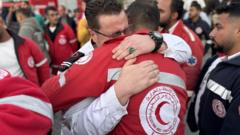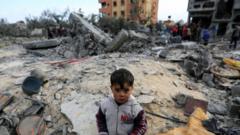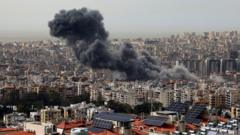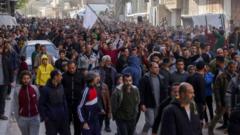Israeli forces demanded residents near Beirut to evacuate for the first time since a cease-fire began, amidst ongoing military threats and concerns of renewed conflict.
Israel Orders Evacuation of Residents Near Beirut Amid Rising Tensions

Israel Orders Evacuation of Residents Near Beirut Amid Rising Tensions
The Israeli military has ordered an evacuation in a Hezbollah-controlled area as tensions escalate following rocket attacks.
The Israeli military has issued an evacuation order for residents of the Hadath neighborhood in Dahiya, a suburb of Beirut controlled by Hezbollah. This is the first such order since a U.S.-brokered cease-fire took effect in November. The evacuation order comes in response to recent rocket fire targeting northern Israel, which prompted fears of renewed conflict.
Avichay Adraee, a spokesperson for the Israeli military, highlighted the targeted structure in a social media post, mandating anyone within approximately 300 yards to leave immediately. He cited concerns regarding “facilities” linked to Hezbollah. Following the outbreak of hostilities on October 7, 2023, when Hamas attacked Israel, Hezbollah began to engage in military actions, launching rockets and drones in support of Hamas.
Despite the cease-fire agreement, Israeli forces have continued to launch attacks on suspected Hezbollah positions in southern Lebanon. However, the Dahiya area had remained untouched by Israeli airstrikes since the truce. With air-raid sirens sounding in northern Israel, reports indicate that at least one incoming rocket was intercepted, while another landed in Lebanese territory. Hezbollah has denied any participation in the recent escalations, reaffirming their adherence to the cease-fire.
In response to the rocket activities near Kiryat Shmona, Israeli Defense Minister Israel Katz threatened action against Beirut, stating, “If it’s not quiet in Kiryat Shmona and the Galilee, it shall not be quiet in Beirut.”
In Dahiya, tensions ran high as residents attempted to alert others to the potential threat. Elie Hachem, director of a local hospital, recounted a chaotic scene with panicked residents. Although the hospital suffered damage during the initial stages of the conflict, plans for evacuation were not immediately enacted as they focused on maintaining calm in the community.
As the situation continues to unfold, residents of Dahiya remain on edge amid escalating military threats and potential ramifications of renewed conflict.
Avichay Adraee, a spokesperson for the Israeli military, highlighted the targeted structure in a social media post, mandating anyone within approximately 300 yards to leave immediately. He cited concerns regarding “facilities” linked to Hezbollah. Following the outbreak of hostilities on October 7, 2023, when Hamas attacked Israel, Hezbollah began to engage in military actions, launching rockets and drones in support of Hamas.
Despite the cease-fire agreement, Israeli forces have continued to launch attacks on suspected Hezbollah positions in southern Lebanon. However, the Dahiya area had remained untouched by Israeli airstrikes since the truce. With air-raid sirens sounding in northern Israel, reports indicate that at least one incoming rocket was intercepted, while another landed in Lebanese territory. Hezbollah has denied any participation in the recent escalations, reaffirming their adherence to the cease-fire.
In response to the rocket activities near Kiryat Shmona, Israeli Defense Minister Israel Katz threatened action against Beirut, stating, “If it’s not quiet in Kiryat Shmona and the Galilee, it shall not be quiet in Beirut.”
In Dahiya, tensions ran high as residents attempted to alert others to the potential threat. Elie Hachem, director of a local hospital, recounted a chaotic scene with panicked residents. Although the hospital suffered damage during the initial stages of the conflict, plans for evacuation were not immediately enacted as they focused on maintaining calm in the community.
As the situation continues to unfold, residents of Dahiya remain on edge amid escalating military threats and potential ramifications of renewed conflict.




















